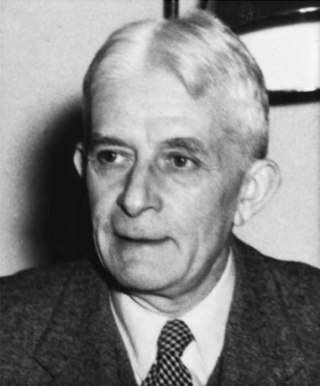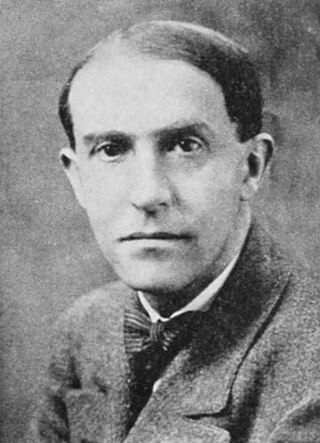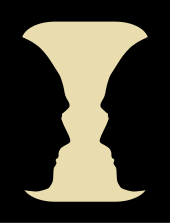Gestalt psychology, gestaltism, or configurationism is a school of psychology and a theory of perception that emphasises the processing of entire patterns and configurations, and not merely individual components. It emerged in the early twentieth century in Austria and Germany as a rejection of basic principles of Wilhelm Wundt's and Edward Titchener's elementalist and structuralist psychology.

Max Wertheimer was a psychologist who was one of the three founders of Gestalt psychology, along with Kurt Koffka and Wolfgang Köhler. He is known for his book, Productive Thinking, and for conceiving the phi phenomenon as part of his work in Gestalt psychology.

Wolfgang Köhler was a German psychologist and phenomenologist who, like Max Wertheimer and Kurt Koffka, contributed to the creation of Gestalt psychology.

Edward Chace Tolman was an American psychologist and a professor of psychology at the University of California, Berkeley. Through Tolman's theories and works, he founded what is now a branch of psychology known as purposive behaviorism. Tolman also promoted the concept known as latent learning first coined by Blodgett (1929). A Review of General Psychology survey, published in 2002, ranked Tolman as the 45th most cited psychologist of the 20th century.
Gestalt Theoretical Psychotherapy(GTP) is a method of psychotherapy based strictly on Gestalt psychology. Its origins go back to the 1920s when Gestalt psychology founder Max Wertheimer, Kurt Lewin and their colleagues and students started to apply the holistic and systems theoretical Gestalt psychology concepts in the field of psychopathology and clinical psychology. Through holism, "a person's thinking, feeling, actions, perceptions, attitudes and logical operations" are seen as one unity. Many developments in psychotherapy in the following decades drew from these early beginnings, like e.g. group psychoanalysis (S. Foulkes), Gestalt therapy (Laura Perls, Fritz Perls, Goodman, and others), or Katathym-imaginative Psychotherapy (Hanscarl Leuner).
Wolfgang Metzger is considered one of the main representatives of Gestalt psychology in Germany.
The Berlin School of Experimental Psychology was founded by Carl Stumpf, a pupil of Franz Brentano and Hermann Lotze and a professor at the University of Berlin, in 1893. It adhered to the method of experimental phenomenology, which understood it as the science of phenomena. It is also noted as the originator of Gestalt psychology. Noted members include Max Wertheimer, Kurt Koffka, and Wolfgang Köhler.
James Jerome Gibson was an American psychologist and is considered to be one of the most important contributors to the field of visual perception. Gibson challenged the idea that the nervous system actively constructs conscious visual perception, and instead promoted ecological psychology, in which the mind directly perceives environmental stimuli without additional cognitive construction or processing. A Review of General Psychology survey, published in 2002, ranked him as the 88th most cited psychologist of the 20th century, tied with John Garcia, David Rumelhart, Louis Leon Thurstone, Margaret Floy Washburn, and Robert S. Woodworth.
Fritz Heider was an Austrian psychologist whose work was related to the Gestalt school. In 1958 he published The Psychology of Interpersonal Relations, which expanded upon his creations of balance theory and attribution theory. This book presents a wide-range analysis of the conceptual framework and the psychological processes that influence human social perception. It had taken 15 years to complete; before it was completed it had already circulated through a small group of social psychologists.

Figure–ground organization is a type of perceptual grouping that is a vital necessity for recognizing objects through vision. In Gestalt psychology it is known as identifying a figure from the background. For example, black words on a printed paper are seen as the "figure", and the white sheet as the "background".
Psychology is defined as "the scientific study of behavior and mental processes". Philosophical interest in the human mind and behavior dates back to the ancient civilizations of Egypt, Persia, Greece, China, and India.

Kurt Lewin was a German-American psychologist, known as one of the modern pioneers of social, organizational, and applied psychology in the United States. During his professional career Lewin applied himself to three general topics: applied research, action research, and group communication.

Kurt Goldstein was a German neurologist and psychiatrist who created a holistic theory of the organism. Educated in medicine, Goldstein studied under Carl Wernicke and Ludwig Edinger where he focused on neurology and psychiatry. His clinical work helped inspire the establishment of The Institute for Research into the Consequences of Brain Injuries. Goldstein was forced to leave Germany when Hitler came to power because of his Jewish heritage. After being displaced, Goldstein wrote The Organism (1934). This focused on patients with psychological disorders, particularly cases of schizophrenia and war trauma, and the ability of their bodies to readjust to substantial losses in central control. His holistic approach to the human organism produced the principle of self actualization, defined as the driving force that maximizes and determines the path of an individual. Later, his principle influenced Abraham Maslow's hierarchy of needs. He was the co-editor of Journal of Humanistic Psychology.
Molly Harrower was an American clinical psychologist. During the Second World War she created a large-scale multiple choice Rorschach test. She was one of the first clinical psychologists to open a private practice. Specializing in diagnostics, Harrower developed a scale allowing practitioners to predict which patients would profit from psychotherapy.
Robert Morris Ogden (1877–1959) was an American psychologist and academic. He served as the dean of the Cornell University College of Arts and Sciences from 1923 to 1945. He was the first proponent of Gestalt psychology in the United States.

Mary Henle was an American psychologist who's known most notably for her contributions to Gestalt Psychology and for her involvement in the American Psychological Association. Henle also taught at the New School of Social Research in New York; she was involved in the writing of eight book publications and also helped develop the first psychology laboratory manual in 1948 based on the famous works of Kurt Lewin.

Kurt Koffka was a German psychologist and professor. He was born and educated in Berlin, Germany; he died in Northampton, Massachusetts, from coronary thrombosis. He was influenced by his maternal uncle, a biologist, to pursue science. He had many interests including visual perception, brain damage, sound localization, developmental psychology, and experimental psychology. He worked alongside Max Wertheimer and Wolfgang Köhler to develop Gestalt psychology. Koffka had several publications including "The Growth of the Mind: An Introduction to Child Psychology" (1924) and "The Principles of Gestalt Psychology" (1935) which elaborated on his research.

The Kurt-Koffka Medal, Kurt Koffka Medal, Kurt Koffka Award, or Koffka Prize is an annual, international award bestowed by Giessen University's Department of Psychology for "advancing the fields of perception or developmental psychology to an extraordinary extent". The prize commemorates the German psychologist Kurt Koffka, a pioneer of Gestalt Psychology, in particular in the fields of perception and developmental psychology. Koffka worked at Giessen University for 16 years, from 1911 to 1927. The medal was first awarded in 2007.
Friedrich Koffka was a German lawyer and writer.









